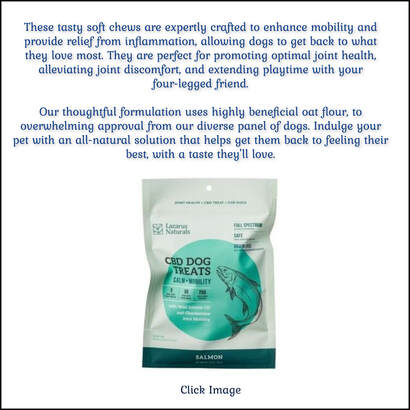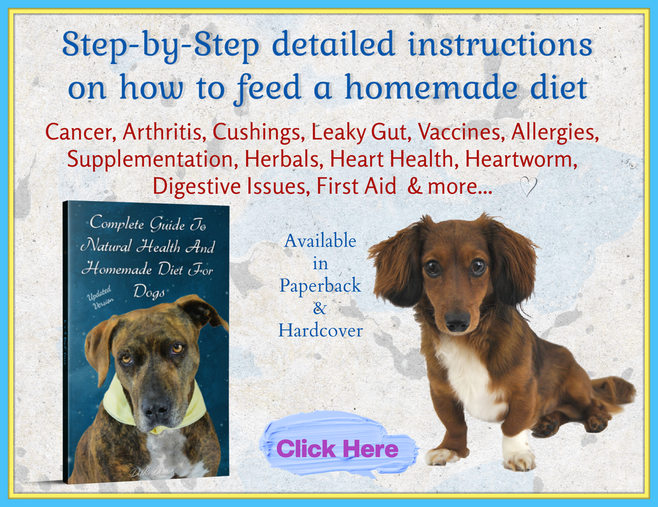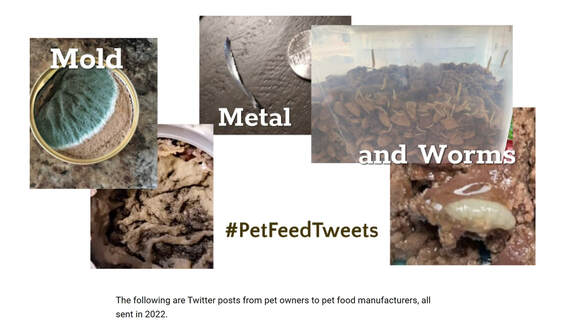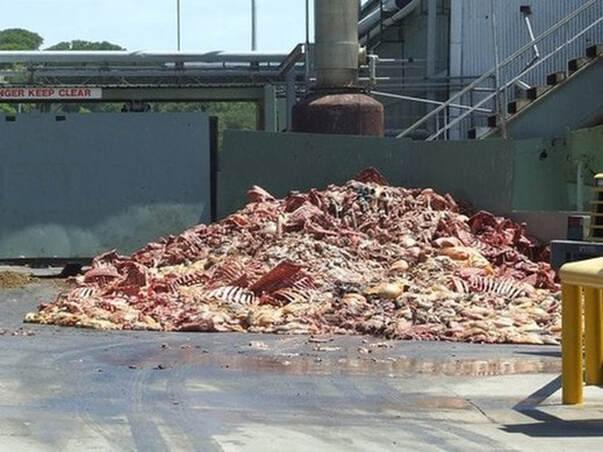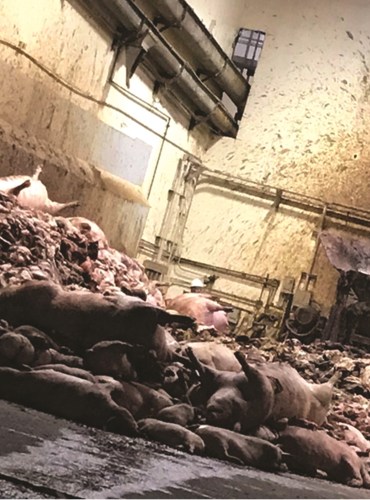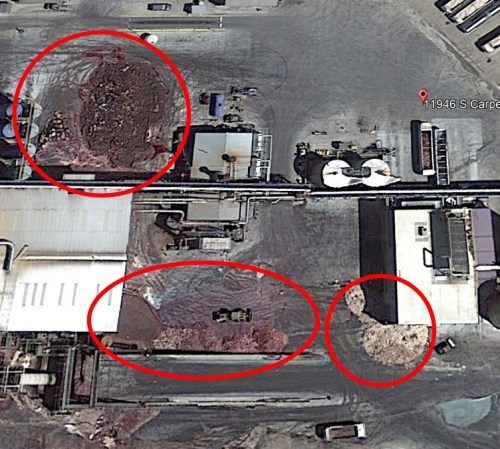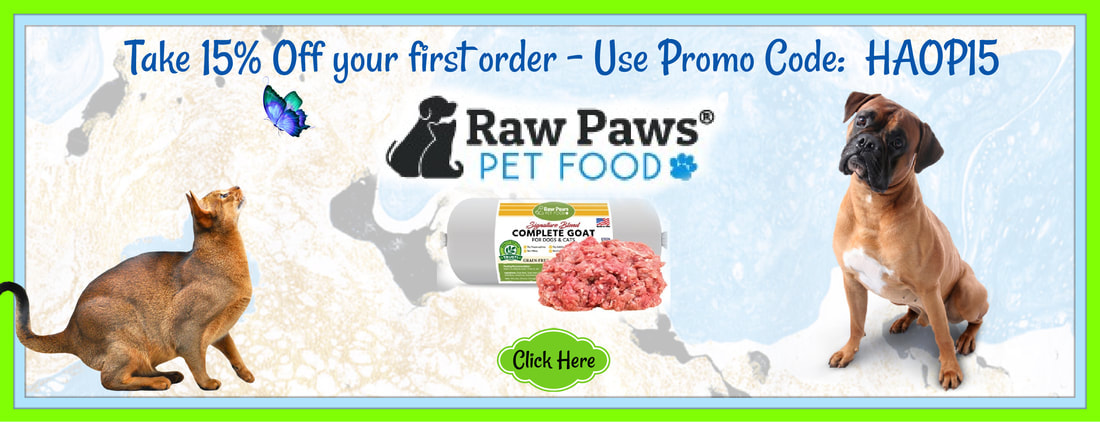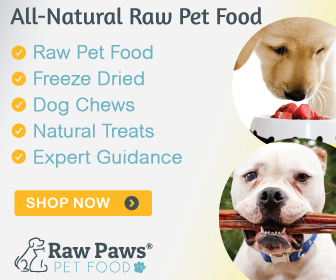~Cooking with fluoridated water simply concentrates fluoride (neurotoxin) in the food, a point that all pet food manufacturers must consider in addition to the ingredients they use in their manufactured pet foods.~
In an article by Dr Karen Becker with Healthy Pets Mercola.~Dr Becker asks.....Have We Chosen Convenience Over the Health of Our Pets?
No one really argues with the fact that in order for optimal health to occur, animals – including humans -- must consume the foods they were designed to eat, and preferably whole, fresh and unadulterated. This is known as species-appropriate nutrition. For example, vegetarian animals must eat vegetation for optimal health. Carnivores must eat fresh whole prey for optimal health.
Carnivorous pets have not evolved to digest and assimilate foods like corn, wheat, rice or potatoes – yet these are the very foods the vast majority of pet food manufacturers use as primary ingredients in their formulas. Fortunately, dogs and cats are extremely resilient creatures. Not only do they not die immediately upon eating biologically inappropriate foods, but it often takes years before the significant physical degeneration that occurs from a lifetime of eating the wrong foods becomes noticeable.
No one really argues with the fact that in order for optimal health to occur, animals – including humans -- must consume the foods they were designed to eat, and preferably whole, fresh and unadulterated. This is known as species-appropriate nutrition. For example, vegetarian animals must eat vegetation for optimal health. Carnivores must eat fresh whole prey for optimal health.
Carnivorous pets have not evolved to digest and assimilate foods like corn, wheat, rice or potatoes – yet these are the very foods the vast majority of pet food manufacturers use as primary ingredients in their formulas. Fortunately, dogs and cats are extremely resilient creatures. Not only do they not die immediately upon eating biologically inappropriate foods, but it often takes years before the significant physical degeneration that occurs from a lifetime of eating the wrong foods becomes noticeable.
|
One of the reasons we’re able to deceive ourselves into believing convenience pet foods are good for dogs and cats is because the changes to a pet’s health and vitality brought on by a dead, processed diet are usually not immediate or acute.
For over a half-century, our pets have been fed inappropriate diets that have kept them alive, but not thriving. In fact, we’ve created dozens of generations of animals that suffer from degenerative diseases linked to nutritional deficiencies. |
Also in another article called "This 5-Minute Process Creates DRASTIC Changes to Your Pet's Food...written by Dr Becker:
According to the Animal Nutrition Group at Wageningen University in the Netherlands, studies show drying pet food at 160°C (320°F) to 180°C (356°F) can significantly reduce its nutritional value.
According to the Animal Nutrition Group at Wageningen University in the Netherlands, studies show drying pet food at 160°C (320°F) to 180°C (356°F) can significantly reduce its nutritional value.
In the smaller size kibble used in the study (4 mm or about .16 inch), a drying temperature of 200°C (392°F) lowered concentrations of the following amino acids:
The same size kibble dried at 120°C (248°F) had a higher ratio of reactive to total lysine than the kibble dried at the higher temperature.
- Proline
- Total lysine
- Reactive lysine (lysine that has remained unchanged during processing)
The same size kibble dried at 120°C (248°F) had a higher ratio of reactive to total lysine than the kibble dried at the higher temperature.
The drying temp of 200°C also decreased concentrations of linolenic (omega-3) and linoleic (omega-6) fatty acids, and increased the concentration of oleic acid (omega-9 monounsaturated). The increase in oleic acid may point to lipid oxidation of the smaller kibbles during the drying process. Lipid oxidation can create off-flavors and aromas, as well as potentially toxic compounds.
Larger size kibble (8 mm or .31 inch) showed only a lowered concentration of reactive lysine, according to study results.
Larger size kibble (8 mm or .31 inch) showed only a lowered concentration of reactive lysine, according to study results.
Dr. Becker's Comments:
The news that processed dry pet food is lacking in nutrients will be no surprise to regular readers of my newsletter. But it’s good to see mainstream sites like PetfoodIndustry.com report on research that provides pet owners with a better understanding of the quality of food they feed to their beloved companion animals. And it’s especially encouraging to see some of the inherent problems in feeding dry processed pet food brought to light.
The news that processed dry pet food is lacking in nutrients will be no surprise to regular readers of my newsletter. But it’s good to see mainstream sites like PetfoodIndustry.com report on research that provides pet owners with a better understanding of the quality of food they feed to their beloved companion animals. And it’s especially encouraging to see some of the inherent problems in feeding dry processed pet food brought to light.
Available on Netflix and many other places
The Extrusion Process
Extrusion is a process that has been used by the pet food industry for over 50 years. About 95 percent of dry pet diets are manufactured using the extrusion process.
Batches of dog or cat food ingredients are mixed, sheared and heated under high pressure, forced through a spiral shaped screw and then through the die of the extruder machine. There are two types of extruders, single screw and twin-screw.
Extrudate is the result -- a ribbon-like product that is then knife-cut and dried.
The high temperature used in extrusion (nearly 400°F) and the short time frame to process (under five minutes) create continuous chemical and physical alterations to the ingredient mixture.
When it comes to the ingredients used in dry dog foods, which are often of low quality to begin with, the first two items on the list, despite what you may think, are actually desirable changes. These changes are necessary to form the physical characteristics of kibble and make it more digestible and assimilable.
The other two items, vitamin loss and certain types of protein denaturation, are undesirable results of the extrusion process.
While the article linked above primarily addresses the effects of the drying process that follows extrusion, let’s take a closer look at the four changes that occur during the extrusion process itself.
Extrusion is a process that has been used by the pet food industry for over 50 years. About 95 percent of dry pet diets are manufactured using the extrusion process.
Batches of dog or cat food ingredients are mixed, sheared and heated under high pressure, forced through a spiral shaped screw and then through the die of the extruder machine. There are two types of extruders, single screw and twin-screw.
Extrudate is the result -- a ribbon-like product that is then knife-cut and dried.
The high temperature used in extrusion (nearly 400°F) and the short time frame to process (under five minutes) create continuous chemical and physical alterations to the ingredient mixture.
- These changes include:
- Starch gelatinization
- Inactivation of nutritionally active factors
- Protein denaturation
- Vitamin loss
When it comes to the ingredients used in dry dog foods, which are often of low quality to begin with, the first two items on the list, despite what you may think, are actually desirable changes. These changes are necessary to form the physical characteristics of kibble and make it more digestible and assimilable.
The other two items, vitamin loss and certain types of protein denaturation, are undesirable results of the extrusion process.
While the article linked above primarily addresses the effects of the drying process that follows extrusion, let’s take a closer look at the four changes that occur during the extrusion process itself.
Great Webinar About Nutrition
Starch Gelatinization
As I often point out in my videos and the newsletter, all dry pet foods contain starch, because starch is essential to the formation of kibble. When pet food ingredients are exposed to heat and moisture during extrusion, the starch in the mixture gelatinizes – it melts. This helps bind the kibble and also causes expansion of the product after it travels through the die.
As I often point out in my videos and the newsletter, all dry pet foods contain starch, because starch is essential to the formation of kibble. When pet food ingredients are exposed to heat and moisture during extrusion, the starch in the mixture gelatinizes – it melts. This helps bind the kibble and also causes expansion of the product after it travels through the die.
A high starch content of 30 to 40 percent of the ingredient mixture decreases the density and therefore the weight of the end product. Dry cat and puppy foods normally contain about 30 percent starch, and 40 percent is typical in dog foods.
Those starch content percentages are average. However, some dry pet food formulas can contain twice that amount. The starch is derived primarily from cereal grains, and as most of you are aware, grains are not biologically appropriate nutrition for dogs or cats.
Interestingly, the extrusion process is thought to lessen the biological inappropriateness of the grain content in dry pet food formulas. According to the Animal Nutrition Group’s report linked above:
Those starch content percentages are average. However, some dry pet food formulas can contain twice that amount. The starch is derived primarily from cereal grains, and as most of you are aware, grains are not biologically appropriate nutrition for dogs or cats.
Interestingly, the extrusion process is thought to lessen the biological inappropriateness of the grain content in dry pet food formulas. According to the Animal Nutrition Group’s report linked above:
One of the challenges when using cereals in canine diets is the presence of anti-nutritional factors that are harmful for dogs. Study on NAF [nutritionally active factors] in canine diets show that extrusion cooking inactivates NAF activity especially those of a proteinaceous structure (Purushotham et al., 2007).
I’ll discuss more about nutritionally active factors shortly.
Another starch-related fact mentioned in the report is that extrusion conditions and the type of starch used can affect glucose and insulin response in dogs after a meal of dry food.
Extruded rice causes a higher glucose and insulin response than other extruded starches like barley, corn, wheat and sorghum. Since rice is considered by many pet owners to be a healthier grain than others, this is good information for those of you who have a pet with diabetes or an overweight dog or cat at risk for the disease.
I’ll discuss more about nutritionally active factors shortly.
Another starch-related fact mentioned in the report is that extrusion conditions and the type of starch used can affect glucose and insulin response in dogs after a meal of dry food.
Extruded rice causes a higher glucose and insulin response than other extruded starches like barley, corn, wheat and sorghum. Since rice is considered by many pet owners to be a healthier grain than others, this is good information for those of you who have a pet with diabetes or an overweight dog or cat at risk for the disease.
Inactivation of Nutritionally Active Factors
The ingredients used in dry pet food mixtures, in particular grain legumes, contain undesirable nutritionally active factors (NAFs) that interfere with digestion and absorption of nutrients.
An example of nutritionally active factors is trypsin inhibitors, also called protese inhibitors. These toxins are most often associated with soy products. Trypsin inhibitors are chemicals that reduce the availability of trypsin, an enzyme crucial for digestion.
The good news is the extrusion process used in the manufacture of dry pet food inactivates undesirable NAFs in the ingredient mixture. It also reduces the activity of naturally occurring toxins like allergens, glycoalkaloids and mycotoxins present in grains prior to extrusion. Unfortunately, the extrusion process doesn’t entirely eliminate the activity of these toxic substances. Mycotoxins are still a big risk in dry pet foods even after the manufacturing process is complete.
Since the presence of NAFs limits the amount of grain used in pet food ingredient mixes, if the extrusion process deactivates the NAFs, then the not-so-good news is that even higher percentages of grain could be added to dry food formulas. Grain is much cheaper than biologically appropriate ingredients like meat and vegetables.
The ingredients used in dry pet food mixtures, in particular grain legumes, contain undesirable nutritionally active factors (NAFs) that interfere with digestion and absorption of nutrients.
An example of nutritionally active factors is trypsin inhibitors, also called protese inhibitors. These toxins are most often associated with soy products. Trypsin inhibitors are chemicals that reduce the availability of trypsin, an enzyme crucial for digestion.
The good news is the extrusion process used in the manufacture of dry pet food inactivates undesirable NAFs in the ingredient mixture. It also reduces the activity of naturally occurring toxins like allergens, glycoalkaloids and mycotoxins present in grains prior to extrusion. Unfortunately, the extrusion process doesn’t entirely eliminate the activity of these toxic substances. Mycotoxins are still a big risk in dry pet foods even after the manufacturing process is complete.
Since the presence of NAFs limits the amount of grain used in pet food ingredient mixes, if the extrusion process deactivates the NAFs, then the not-so-good news is that even higher percentages of grain could be added to dry food formulas. Grain is much cheaper than biologically appropriate ingredients like meat and vegetables.
Protein Denaturation
The protein sources used in dry pet food formulas are often a combination of animal and vegetable, because less costly vegetable protein doesn’t contain amino acids sufficient for the nutritional needs of carnivorous dogs and cats.
And speaking of amino acids, they don’t fare well during extrusion. In fact, a recent study cited in the Animal Nutrition Group report,
“… observed a large overestimation of the available lysine content such that the amino acid pattern relative to lysine in these diets may not be optimal to promote health. In addition to lysine, other amino acids such as arginine, tryptophan, cysteine and histidine can also be affected by the extrusion process. Of particular importance may be the sulphur amino acids (cysteine and methionine) which are often limiting in diets for cats as these amino acids are susceptible to oxidation.”
But back to the topic of protein denaturation, according to the Animal Nutrition Group report:
Mild denaturation of proteins can make them more susceptible to digestive enzymes and, therefore, improve the digestibility of these proteins (Hendriks and Sritharan, 2002).
The protein sources used in dry pet food formulas are often a combination of animal and vegetable, because less costly vegetable protein doesn’t contain amino acids sufficient for the nutritional needs of carnivorous dogs and cats.
And speaking of amino acids, they don’t fare well during extrusion. In fact, a recent study cited in the Animal Nutrition Group report,
“… observed a large overestimation of the available lysine content such that the amino acid pattern relative to lysine in these diets may not be optimal to promote health. In addition to lysine, other amino acids such as arginine, tryptophan, cysteine and histidine can also be affected by the extrusion process. Of particular importance may be the sulphur amino acids (cysteine and methionine) which are often limiting in diets for cats as these amino acids are susceptible to oxidation.”
But back to the topic of protein denaturation, according to the Animal Nutrition Group report:
Mild denaturation of proteins can make them more susceptible to digestive enzymes and, therefore, improve the digestibility of these proteins (Hendriks and Sritharan, 2002).
Denaturation takes place during the extrusion process, and often prior in the case of animal proteins, which are heated after grinding to a target temperature before being added to the ingredient mixture.
Denaturation modifies the structure of protein. In the case of plant-based proteins like soy and corn, denaturation makes these biologically inappropriate foods easier for pets to digest. However, denaturation is only beneficial to meat-based proteins if the protein sources are substandard, which of course they are in the vast majority of popular dry dog and cat food diets. Rendered meat by-products are a common protein source in dry kibble, and they are indeed difficult for dogs and cats to digest and assimilate.
Unfortunately, denaturation of high quality, lean, whole cuts of meat used in superior quality dry pet foods also occurs. As you might guess, denaturation of biologically appropriate protein has the opposite effect of what is achieved with grain-based and low-grade animal meat. Denaturation makes these once healthy proteins more difficult for your dog or cat to digest and assimilate.
The change in the structure of healthy protein that occurs during exposure to high heat is a possible trigger for food allergies. Research shows the immune system may not recognize the altered protein structure and treats it as a foreign invader. This may explain why pets allergic to a particular meat-based dry food oftentimes have no problem eating that same meat in whole, raw form.
According to the report:
Protein digestibility of extrudates was increased compared to nonextruded samples (Peri et al., 1983; Bhattacharya and Hanna, 1985; Fapojuwo et al., 1987). These studies were, however, conducted on feeds composed from vegetable sources only.
|
Enzymes like lipoxygenase and peroxidase present in pet food ingredient mixes are inactivated during extrusion cooking. Since these enzymes can cause deterioration of product and shorten shelf life, their destruction is considered by pet food manufacturers to be a beneficial effect of the extrusion process.
|
Vitamin Loss
According to the Animal Nutrition Group report, the extrusion process primarily destroys vitamin A, vitamin E and the B-group vitamins in dry food ingredient mixtures. No data on vitamins D or K was available for the report.
The percentage of vitamin loss during extrusion varies widely, from a low of 4 percent loss of thiamine to a high of 65 percent loss of vitamin A.
Keep in mind that B-group vitamins are water soluble, meaning your pet’s body can’t store them – they must be provided daily through diet. ~Dr Becker.
Mycotoxins
Before you start moistening your pet's food to try to replace the missing moisture, you should know about mycotoxins, another potential side effect of the use of grains in pet food. Mycotoxins are naturally occurring fungal by-products that can cause disease and death in dogs and cats. When grains are improperly stored, mycotoxins can develop. Two common forms, both of which have been found in pet food (more commonly in dog food) are aflatoxin and vomitoxin. Although mycotoxins are found worldwide they only become toxic in temperatures above 82 degrees and over 80 percent humidity at which point they interfere with cellular function, and are extremely carcinogenic and immunosuppressive.
Aflatoxin B1 is the most toxic of the aflatoxins and is the most potent liver carcinogen known. Substantial evidence exists to indicate that low-level exposure to aflatoxin may cause suppression of the immune system and increase susceptibility to disease. Young and pregnant animals of all species are extremely sensitive to aflatoxins. Aflatoxin is also excreted in milk of dams and may contribute to reproductive failure. Exposure during pregnancy has resulted in transplacental transfer of aflatoxin to and immune dysfunction in offspring.
According to the Animal Nutrition Group report, the extrusion process primarily destroys vitamin A, vitamin E and the B-group vitamins in dry food ingredient mixtures. No data on vitamins D or K was available for the report.
The percentage of vitamin loss during extrusion varies widely, from a low of 4 percent loss of thiamine to a high of 65 percent loss of vitamin A.
Keep in mind that B-group vitamins are water soluble, meaning your pet’s body can’t store them – they must be provided daily through diet. ~Dr Becker.
Mycotoxins
Before you start moistening your pet's food to try to replace the missing moisture, you should know about mycotoxins, another potential side effect of the use of grains in pet food. Mycotoxins are naturally occurring fungal by-products that can cause disease and death in dogs and cats. When grains are improperly stored, mycotoxins can develop. Two common forms, both of which have been found in pet food (more commonly in dog food) are aflatoxin and vomitoxin. Although mycotoxins are found worldwide they only become toxic in temperatures above 82 degrees and over 80 percent humidity at which point they interfere with cellular function, and are extremely carcinogenic and immunosuppressive.
Aflatoxin B1 is the most toxic of the aflatoxins and is the most potent liver carcinogen known. Substantial evidence exists to indicate that low-level exposure to aflatoxin may cause suppression of the immune system and increase susceptibility to disease. Young and pregnant animals of all species are extremely sensitive to aflatoxins. Aflatoxin is also excreted in milk of dams and may contribute to reproductive failure. Exposure during pregnancy has resulted in transplacental transfer of aflatoxin to and immune dysfunction in offspring.
FEEDING A HOMEMADE (RAW OR COOKED) DIET FOR YOUR DOG - 2019
The elimination of mycotoxins in food is extremely expensive. Pet food manufacturers are not known for using the highest quality grains available; they would not be able to keep up their high profit margins if they did. The grains most pet food manufacturers use are those that are not fit for human consumption or are by-products from other processes.
Dr Becker also states: "Very little regulation of commercial pet food quality exists in the U.S. Neither the USDA nor the FDA gets involved in what is fed to the majority of companion animals in this country."~Dr. Becker.
~We know that dogs and cats are carnivores, so why do we continue to feed these foods? Not only are the ingredients extremely questionable, pet food companies have no obligation to provide the details of the ingredients. In fact they go out of the way to try to change the names on contents to throw you off. They will switch one preservative with some unpronounceable name for another. Even if the foods are processed here in the United States and Canada, doesn't mean it wasn't sourced from China. And if you ask them, they may tell you they ARE made and sourced in the USA..but that may not be true at all. And they can even change the source at anytime without notifying its buyers. Most all vitamins are sourced from China--even human vitamins, so it's best to buy from a reputable company. These large companies are hiding so much of the truth of what is truly in these foods, it's off the charts scary. DO NOT BUY pet food containing corn or soy in any form on the shelf. Corn is a cheap filler ingredient, loaded with GMOs, non-nutritious for pets, and a known allergenic. Wheat is a big source of food allergies as well and can cause intestinal upset. Soy (full of GMOs) is estrogenic and wreaks havoc on your pet’s endocrine system.
Dr Becker also states: "Very little regulation of commercial pet food quality exists in the U.S. Neither the USDA nor the FDA gets involved in what is fed to the majority of companion animals in this country."~Dr. Becker.
~We know that dogs and cats are carnivores, so why do we continue to feed these foods? Not only are the ingredients extremely questionable, pet food companies have no obligation to provide the details of the ingredients. In fact they go out of the way to try to change the names on contents to throw you off. They will switch one preservative with some unpronounceable name for another. Even if the foods are processed here in the United States and Canada, doesn't mean it wasn't sourced from China. And if you ask them, they may tell you they ARE made and sourced in the USA..but that may not be true at all. And they can even change the source at anytime without notifying its buyers. Most all vitamins are sourced from China--even human vitamins, so it's best to buy from a reputable company. These large companies are hiding so much of the truth of what is truly in these foods, it's off the charts scary. DO NOT BUY pet food containing corn or soy in any form on the shelf. Corn is a cheap filler ingredient, loaded with GMOs, non-nutritious for pets, and a known allergenic. Wheat is a big source of food allergies as well and can cause intestinal upset. Soy (full of GMOs) is estrogenic and wreaks havoc on your pet’s endocrine system.
Here is a statement from a pet food company:
Chicken meal is an ingredient used by many pet food manufacturers because it is cheaper, easier to produce with, and can be stored for longer. Chicken meal is made by taking the “leftovers” of chicken after meat has been removed for human use. This is cooked in a process called rendering: grinding the chicken down and cooking it at very high temperatures for several hours to make a powder or meal. And because chicken meal legally can contain 4D animals (dead, dying, diseased or disabled chickens), it is not permitted for human consumption.
Pet food companies are famous for using the cheapest grains they can find that are by-products of the human food industry. WHY? How many recalls have we seen in the past several years? And it's apparent it will only get worse. Bags of dry pet foods have been filled with mold, rodents, worms, & moths to name a few. And how many bags have made humans sick from salmonella? Tons!
To read more on human illnesses in pet food plants. Pet Food Safety Advocate Susan Thixton from TruthAboutPetFood.com provides detailed information on human illnesses and disease.
Appetite stimulants and addictive ingredients (salt, sugar, glucose, sucrose, fructose, phosphoric acid) only makes the impact upon the average animal liver much more deadly.
Don't forget your 4-Ds:
4-Ds: Road kill, slaughterhouse rejects, animals that die on their way to meat packing plants - all are acceptable ingredients for pet food under the "4D" rule. Steroids, growth hormones and chemicals used to treat cattle including insecticide patches end up mixed into the final product. Meat from grocery stores past its due date is also added to the mix, as are the Styrofoam trays and plastic wrap they were packed in. The animals brought into shelters and euthanized are where our pet foods come from. There is so much waste that instead of adding to our landfills, these carcasses are shipped to rendering plants (left out to bake in the sun for days) and then processed for pet foods. In other words, our pets are dumping grounds for dead waste. If you would like to read more on this, read an article from TruthAboutPetFood.com's recent article. It's an eye opening tell all.~H.O.P.S.
To read more on human illnesses in pet food plants. Pet Food Safety Advocate Susan Thixton from TruthAboutPetFood.com provides detailed information on human illnesses and disease.
Appetite stimulants and addictive ingredients (salt, sugar, glucose, sucrose, fructose, phosphoric acid) only makes the impact upon the average animal liver much more deadly.
Don't forget your 4-Ds:
4-Ds: Road kill, slaughterhouse rejects, animals that die on their way to meat packing plants - all are acceptable ingredients for pet food under the "4D" rule. Steroids, growth hormones and chemicals used to treat cattle including insecticide patches end up mixed into the final product. Meat from grocery stores past its due date is also added to the mix, as are the Styrofoam trays and plastic wrap they were packed in. The animals brought into shelters and euthanized are where our pet foods come from. There is so much waste that instead of adding to our landfills, these carcasses are shipped to rendering plants (left out to bake in the sun for days) and then processed for pet foods. In other words, our pets are dumping grounds for dead waste. If you would like to read more on this, read an article from TruthAboutPetFood.com's recent article. It's an eye opening tell all.~H.O.P.S.
~Dr Becker also explains: It’s important to note that on pet food labels, ingredients are listed by weight. Because meat is inclusive of water, it is heavy, so it can be listed first on the label. When the water is removed from meat (which happens when a kibbled or dry food is produced) the meat is reduced in weight by roughly 80 percent, meaning the bulk of the food is probably coming from ingredients two, three and four – yet the meat will appear on the label as the first ingredient.
In addition, it’s also important to be aware of a labeling practice known as ‘splitting.’ Splitting occurs when different components of the same ingredient are listed separately on the label to improve the look of the ingredient list.
If, for example, rice makes up 50 percent of a formula and meat only 25 percent, it’s possible to list the rice as three or four individual ingredients all under 25 percent each, for example, brown rice, white rice, rice bran, and rice gluten meal. Listing the ingredient ‘rice’ in this manner allows the manufacturer to list the meat -- at 25 percent -- as the first ingredient.~Dr Becker.
In addition, it’s also important to be aware of a labeling practice known as ‘splitting.’ Splitting occurs when different components of the same ingredient are listed separately on the label to improve the look of the ingredient list.
If, for example, rice makes up 50 percent of a formula and meat only 25 percent, it’s possible to list the rice as three or four individual ingredients all under 25 percent each, for example, brown rice, white rice, rice bran, and rice gluten meal. Listing the ingredient ‘rice’ in this manner allows the manufacturer to list the meat -- at 25 percent -- as the first ingredient.~Dr Becker.
~According to Susan Nelson, DVM and assistant professor of clinical services at Kansas State University:
"Natural and veggie-based pet foods are based more on market demand from owners, not because they are necessarily better for the pet."~
~As stated in a Natural News article: Many pet foods claim to be "100% nutritionally complete and balanced." This claim legally can be made and printed on commercial products based on information studies using isolated nutrients and not whole foods, or by feeding the complete pet food to animals for several weeks to determine whether it prevents obvious disease or malnutrition. Although motivated by an interest to assure quality for the consumer, these tests ignore important nutritional issues and give both producer and consumer a false sense of knowledge and security. Measuring a food's merit by levels of isolated nutrients tells only a partial story. There are more than forty known, essential nutrients, and more than fifty other nutrients are under investigation. Thus, making sure a food contains appropriate amounts of only a dozen of these nutrients can't possibly assure that a food is "complete."
"Natural and veggie-based pet foods are based more on market demand from owners, not because they are necessarily better for the pet."~
~As stated in a Natural News article: Many pet foods claim to be "100% nutritionally complete and balanced." This claim legally can be made and printed on commercial products based on information studies using isolated nutrients and not whole foods, or by feeding the complete pet food to animals for several weeks to determine whether it prevents obvious disease or malnutrition. Although motivated by an interest to assure quality for the consumer, these tests ignore important nutritional issues and give both producer and consumer a false sense of knowledge and security. Measuring a food's merit by levels of isolated nutrients tells only a partial story. There are more than forty known, essential nutrients, and more than fifty other nutrients are under investigation. Thus, making sure a food contains appropriate amounts of only a dozen of these nutrients can't possibly assure that a food is "complete."
Unfortunately, harmful chemical preservatives and other artificial additives are the norm in most pet foods. Some are intentionally added by the manufacturer, while others come from the herbicides, insecticides, and pesticides used by farmers to boost crop yields. Many pet foods advertised as "preservative-free" do, in fact, contain preservatives. As the law is currently written, manufacturers don't have to list preservatives that they themselves did not add. Many preservatives make their way into pet food at rendering plants before the meat is even sent to the manufacturer. An analysis of several pet foods labeled "chemical free" or "all natural ingredients" found synthetic antioxidants in all samples. With continued use, low levels of these synthetic antioxidants may build up in the tissues; ingestion of small doses over time may be just as toxic as a single large dose. About 60 percent of all herbicides, 90 percent of all fungicides, and 30 percent of all insecticides are considered to be cancer causing in and of themselves.
Commission warned that a series of mysterious dog ailments at kennels in Michigan may be the result of fluoride contamination of pet foods. They noticed a high incidence of deformed puppies and pointed out that chronic effects of fluoride poisoning may not be noticeable for a long time.
Commission warned that a series of mysterious dog ailments at kennels in Michigan may be the result of fluoride contamination of pet foods. They noticed a high incidence of deformed puppies and pointed out that chronic effects of fluoride poisoning may not be noticeable for a long time.
Although you won't see it on the label, since it is often added at the rendering plant and not by the manufacturer, ethoxyquin (EQ) is used to preserve most dry pet food. First used as a rubber stabilizer, EQ is the most powerful of all preservatives and may be the most toxic. Originally, it was permitted in livestock food. So since pet food is considered animal feed, the use of EQ is also permitted in pet food. The fish industry uses high levels of EQ; factory workers exposed to it exhibited side effects similar to those of agent orange: a dramatic rise in liver or kidney damage, cancerous skin lesions, hair loss, blindness, leukemia, fetal abnormalities, and chronic diarrhea. In animals, EQ has been linked to immune deficiency syndrome; spleen, stomach, and liver cancers; and a host of allergies.
Slaughterhouses also provide renderers with the leftovers from slaughtered animals not fit for human consumption. Before these animal parts and by-product used for pet food are shipped from the slaughterhouse to the rendering plant, the by-product is "denatured." This means that crude carbolic acid, cresylic disinfectant, or citronella, is sprayed on the product. In the case of a whole beef or swine carcass that has been condemned, the denaturing product is injected into the entire carcass. If meat inspectors condemn only parts of an animal, the United States Department of Agriculture (USDA) requires that "before an approved denaturing agent is applied, the product must be freely slashed so that pieces are less than 4" in diameter. This allows the denaturant to contact all parts of the product." ~NN
Slaughterhouses also provide renderers with the leftovers from slaughtered animals not fit for human consumption. Before these animal parts and by-product used for pet food are shipped from the slaughterhouse to the rendering plant, the by-product is "denatured." This means that crude carbolic acid, cresylic disinfectant, or citronella, is sprayed on the product. In the case of a whole beef or swine carcass that has been condemned, the denaturing product is injected into the entire carcass. If meat inspectors condemn only parts of an animal, the United States Department of Agriculture (USDA) requires that "before an approved denaturing agent is applied, the product must be freely slashed so that pieces are less than 4" in diameter. This allows the denaturant to contact all parts of the product." ~NN
~Feeding kibble to your pet has almost always some irreversible damage. Kibble dehydrates the system leaving it lacking in moisture which therefore causes kidney and bladder stones/crystals. Pets have to drink over 5 times the amount of water to stay hydrated throughout the day. Kibble also causes periodontal disease from buildup of chemicals, addicting additives and preservatives. Kibble almost always causes cancer and/or some form of kidney and liver failure as well as arthritis. It may not occur immediately but over a period of time, it will take its toll on your pet. When pets try to digest the kibble, it has a very difficult time breaking down all the chemicals and additives which overworks the entire digestive system causing other issues like vomiting, diarrhea, IBS, bloody stools, and colon cancer. To have a healthy gut, you must feed a species appropriate diet. This does not include feeding bagged, pouched or canned pet foods. To feed better, purchase human grade foods raw or homecooked (with added supplementing) to balance the diet.
"Running to the store to buy a bag of pet food is nothing more than convenience to the human. But it is a slow death to your pet."
All pet foods including prescription diet foods recommended by your vet, are extremely deadly. Vets did not take a course in nutrition. Large pet food manufacturers like Purina and Hills come and give a 3-4 hour class of why these foods are much better than others and how they can help your pet. It's a ploy to sell more pet foods. Veterinarians do not know any better. And the ones that do, are most likely your holistic veterinarians. Don't be totally trusting in your vet. He/She may not know any better. You, as a pet parent need to be vigilant and know what's best for your pet when it comes to diet, vaccines and medications. If you stand your ground, and still your vet will not accept your way of feeding or denial of vaccines, FIND A NEW VET THAT WILL! No one should tell you what you can and can't do with taking better care of your pet. I only ask one thing, when changing the diet, PLEASE do your homework, research, ask others, get in groups, find the best balanced diet for your pet. It doesn't cost a fortune to feed a super good food to your pets. Even if you buy EXPENSIVE HIGH QUALITY kibble, you're still buying junk and paying a fortune. Why not change to a homemade species appropriate diet? It's cheaper.
Now I hope I have provided solid documentation on why KIBBLE KILLS. Make a change today. You won't regret it! And remember, not only is the pet foods killing pets, so are the deadly tainted toxic treats. If you must buy treats, buy homemade from small mom and pop shops. Check ingredients. BUT DO NOT BUY grocery store or pet store treats!! They will kill also.
As I always say, "Better Safe Than Sorry".
As these pet food manufacturers make you think they care, this is words coming from them and the FDA as well. "It’s just a cat" or "It’s just a dog". It is the WRONG mindset and it must stop now..starting with you! ~ H.O.P.S.
NOTE: (NaturalNews) The USDA has announced its intention to allow China-grown chicken meat to be imported into the USA. "The U.S. Department of Agriculture's Food Safety and Inspection Service (FSIS) has announced that China is eligible to export processed, cooked chicken to the United States," says an official announcement on the USDA website.
As I always say, "Better Safe Than Sorry".
As these pet food manufacturers make you think they care, this is words coming from them and the FDA as well. "It’s just a cat" or "It’s just a dog". It is the WRONG mindset and it must stop now..starting with you! ~ H.O.P.S.
NOTE: (NaturalNews) The USDA has announced its intention to allow China-grown chicken meat to be imported into the USA. "The U.S. Department of Agriculture's Food Safety and Inspection Service (FSIS) has announced that China is eligible to export processed, cooked chicken to the United States," says an official announcement on the USDA website.
And it's still happening today
Other links for reading:
http://truthaboutpetfood.com/iams-proposes-concerning-food-additive-for-pet-food/
http://www.dogsnaturallymagazine.com/the-truth-about-dog-food-and-supplements/?inf_contact_key=24d750f658d38fe8b1467ecc6c97ebbbe882d524b8797e28435aa8d177bd9855
http://truthaboutpetfood2.com/sellyourrottenspoiledwastefoodto-pet-food
http://truthaboutpetfood.com/whats-in-the-bowl
http://healthypets.mercola.com/sites/healthypets/archive/2011/02/15/raw-meat-the-best-and-healthiest-diet-for-pet-cats-and-dogs.aspx
http://truthaboutpetfood2.com/cruel-heartless-words-from-fda-veterinarian
http://truthaboutpetfood.com/iams-proposes-concerning-food-additive-for-pet-food/
http://www.dogsnaturallymagazine.com/the-truth-about-dog-food-and-supplements/?inf_contact_key=24d750f658d38fe8b1467ecc6c97ebbbe882d524b8797e28435aa8d177bd9855
http://truthaboutpetfood2.com/sellyourrottenspoiledwastefoodto-pet-food
http://truthaboutpetfood.com/whats-in-the-bowl
http://healthypets.mercola.com/sites/healthypets/archive/2011/02/15/raw-meat-the-best-and-healthiest-diet-for-pet-cats-and-dogs.aspx
http://truthaboutpetfood2.com/cruel-heartless-words-from-fda-veterinarian


